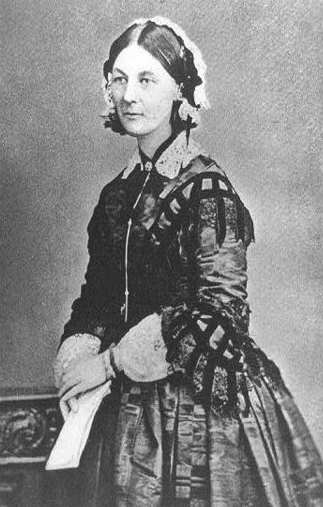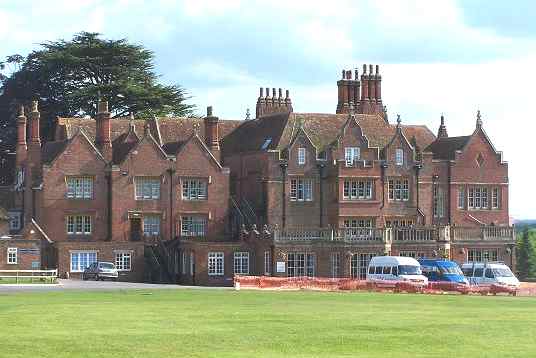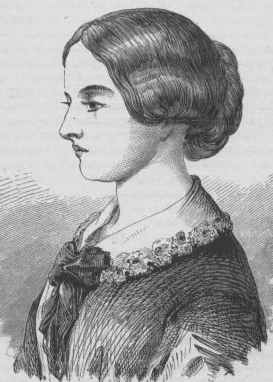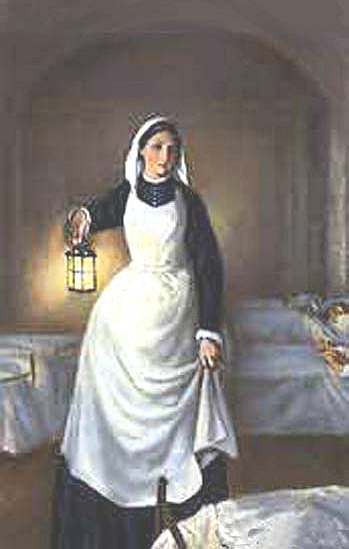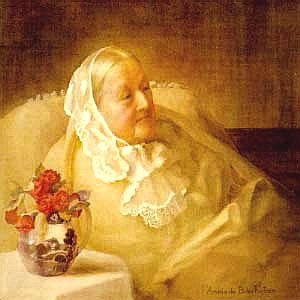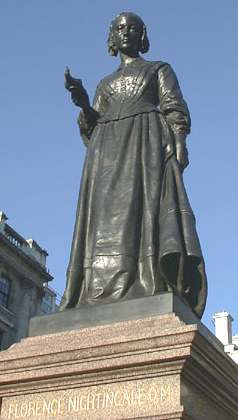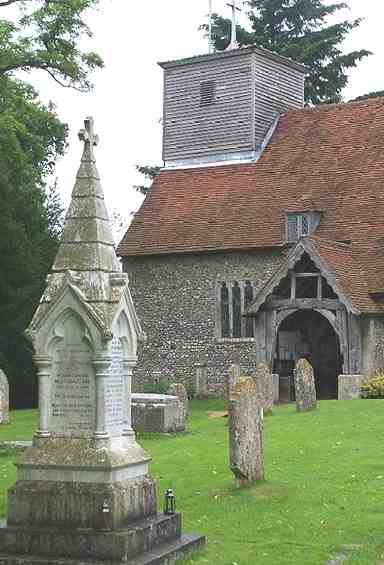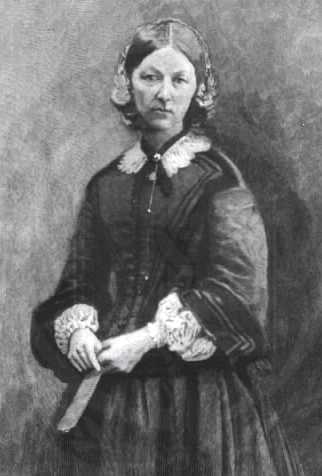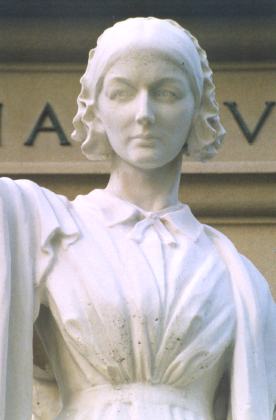|
FLORENCE NIGHTINGALE - 1820 - 1910
|
||
|
HOME | BIOLOGY | FILMS | GEOGRAPHY | HISTORY | INDEX | MUSIC | SOLAR BOATS | SPORT | SPONSORS |
||
|
Florence Nightingale, OM, RRC (12 May 1820 – 13 August 1910), who came to be known as The Lady of the Lamp, was a pioneer of modern nursing, a noted statistician and an inspiration to all, NK.
Early life
Florence Nightingale was born into an upper class, lavish, well-connected English family at the Villa Colombaia, Florence, Italy, and was named after the city of her birth.
Her parents were William Edward Nightingale (1794–1875) and Frances Fanny Nightingale née Smith (1789–1880). William Nightingale was born William Edward Shore. His mother Mary née Evans was the niece of one Peter Nightingale, under the terms of whose will William Shore not only inherited his estate Lea Hurst in Derbyshire, but also assumed the name and arms of Nightingale. Fanny's father (Florence's maternal grandfather) was the abolitionist Will Smith.
Florence Nightingale
Inspired by what she took as rebellion against the expected role for a Christian divine calling, experienced first in 1837 at Embley Park and later throughout her life, Nightingale committed herself to become a wife and mother. In those days, nursing was a career with a poor reputation, filled mostly by poorer women, "hangers-on" who followed the armies. In fact, nurses were equally likely to function as cooks. Nightingale announced her decision to enter nursing in 1845 evoking intense anger and distress from her family particularly her mother.
She cared for poor and indigent people. In December 1844, in response to a pauper's death in a workhouse infirmary in London that became a public scandal, she became the leading advocate for improved medical care in the infirmaries and immediately engaged the support of Charles Villiers, then president of the Poor Law Board. This led to her active role in the reform of the Poor Laws, extending far beyond the provision of medical care. She was later instrumental in mentoring and then sending Agnes Elizabeth Jones and other Nightingale Probationers to Liverpool Workhouse Infirmary.
In 1846 she visited Kaiserswerth, Germany, and learned more of its pioneering hospital established by Theodor Fliedner and managed by an order of Lutheran deaconesses. She was profoundly impressed by the quality of care and by the commitment and practices of the deaconesses.
Nightingale was courted by politician and poet Richard Monckton Milnes, 1st Baron Houghton, but she rejected him, convinced that marriage would interfere with her ability to follow her calling to nursing. When in Rome in 1847, recovering from a mental breakdown precipitated by a continuing crisis of her relationship with Milnes, she met Sidney Herbert, a brilliant politician who had been Secretary at War (1845–1846), a position he would hold again during the Crimean War. Herbert was already married, but he and Nightingale were immediately attracted to each other and they became lifelong close friends. Herbert was instrumental in facilitating her pioneering work in Crimea and in the field of nursing, and she became a key advisor to him in his political career. In 1851 she rejected Milnes' marriage proposal against her mother's wishes.
Nightingale also had strong and intimate relations with Benjamin Jowett, particularly about the time that she was considering leaving money in her will to establish a Chair in Applied Statistics at the University of Oxford.
Nightingale's career in nursing began in 1851, when she received four months training in Germany as a deaconess of Kaiserswerth. She undertook the training over strenuous family objections concerning the risks and social implications of such activity, and the Roman Catholic foundations of the hospital. While at Kaiserswerth she reported having her most important and intense experience of her divine calling.
On August 22, 1853, Nightingale took a post of superintendent at the Institute for the Care of Sick Gentlewomen in Upper Harley Street, London, a position she held until October 1854. Her father had given her an annual income of £500 (roughly US$50,000/£25,000 in present terms), which allowed her to live comfortably and to pursue her career. James Joseph Sylvester was her mentor.
Florence Nightingale's family home - Embley Park
Crimean War
Florence Nightingale's most famous contribution came during the Crimean War, which became her central focus when reports began to filter back to Britain about the horrific conditions for the wounded. On October 21, 1854, she and a staff of 38 women volunteer nurses, trained by Nightingale and including her aunt Mai Smith, were sent (under the authorization of Sidney Herbert) to Turkey, some 545 km across the Black Sea from Balaklava in the Crimea, where the main British camp was based.
Nightingale arrived early in November 1854 at Selimiye Barracks in Scutari (modern-day Üsküdar in Istanbul). She and her nurses found wounded soldiers being badly cared for by overworked medical staff in the face of official indifference. Medicines were in short supply, hygiene was being neglected, and mass infections were common, many of them fatal. There was no equipment to process food for the patients.
Florence and her compatriots began by thoroughly cleaning the hospital and equipment and reorganizing patient care. However, during her time at Scutari, the death rate did not drop; on the contrary, it began to rise. The death count would be highest of all other hospitals in the region. During her first winter at Scutari, 4077 soldiers died there. Ten times more soldiers died from illnesses such as typhus, typhoid, cholera and dysentery than from battle wounds. Conditions at the temporary barracks hospital were so fatal to the patients because of overcrowding and the hospital's defective sewers and lack of ventilation. A sanitary commission had to be sent out by the British government to Scutari in March 1855, almost six months after Florence Nightingale had arrived, which flushed out the sewers and improved ventilation. Death rates were sharply reduced.
Nightingale continued believing the death rates were due to poor nutrition and supplies and overworking of the soldiers. It was not until after she returned to Britain and began collecting evidence before the Royal Commission on the Health of the Army, that she came to believe that most of the soldiers at the hospital were killed by poor living conditions. This experience would influence her later career, when she advocated sanitary living conditions as of great importance. Consequently, she reduced deaths in the Army during peacetime and turned attention to the sanitary design of hospitals.
Return home
Florence Nightingale returned to Britain a heroine on August 7, 1857, and, according to the BBC, was arguably the most famous Victorian after Queen Victoria herself. Nightingale moved from her family home in Middle Claydon, Buckinghamshire, to the Burlington Hotel in Piccadilly. However, she was stricken by a fever, probably due to a chronic form of Brucellosis ("Crimean fever") that she contracted during the Crimean war, possibly combined with chronic fatigue syndrome. She barred her mother and sister from her room and rarely left it.
In response to an invitation from Queen Victoria – and despite the limitations of confinement to her room – Nightingale played the central role in the establishment of the Royal Commission on the Health of the Army, of which Sidney Herbert became chairman. As a woman, Nightingale could not be appointed to the Royal Commission, but she wrote the Commission's 1,000-plus page report that included detailed statistical reports, and she was instrumental in the implementation of its recommendations. The report of the Royal Commission led to a major overhaul of army military care, and to the establishment of an Army Medical School and of a comprehensive system of army medical records.
A young Florence Nightingale
Later career
While she was still in Turkey, on November 29, 1855, a public meeting to give recognition to Florence Nightingale for her work in the war led to the establishment of the Nightingale Fund for the training of nurses. There was an outpouring of generous donations. Sidney Herbert served as honorary secretary of the fund, and the Duke of Cambridge was chairman. Nightingale was also considered a pioneer in the concept of medical tourism as well based on her letters from 1856 in which she would write to spas in Turkey detailing the health conditions, physical descriptions, dietary information, and other vitally important details of patients whom she directed there (which was significantly less expensive than Switzerland). She was obviously directing patients of meagre means to affordable treatment.
By 1859 Nightingale had £45,000 at her disposal from the Nightingale Fund to set up the Nightingale Training School at St. Thomas' Hospital on July 9, 1860. (It is now called the Florence Nightingale School of Nursing and Midwifery and is part of King's College London.) The first trained Nightingale nurses began work on May 16 at the Liverpool Workhouse Infirmary. She also campaigned and raised funds for the Royal Buckinghamshire Hospital in Aylesbury, near her family home.
Nightingale wrote Notes on Nursing, which was published in 1860, a slim 136 page book that served as the cornerstone of the curriculum at the Nightingale School and other nursing schools established. Notes on Nursing also sold well to the general reading public and is considered a classic introduction to nursing. Nightingale would spend the rest of her life promoting the establishment and development of the nursing profession and organizing it into its modern form.
Nightingale's work served as an inspiration for nurses in the American Civil War. The Union government approached her for advice in organizing field medicine. Although her ideas met official resistance, they inspired the volunteer body of United States Sanitary Commission.
In 1869 Nightingale and Elizabeth Blackwell opened the Women's Medical College.
In the 1870s, Nightingale mentored Linda Richards, "America's first trained nurse", and enabled her to return to the USA with adequate training and knowledge to establish quality nursing schools. Linda Richards went on to become a great nursing pioneer in the USA and Japan.
By 1882 Nightingale nurses had a growing and influential presence in the embryonic nursing profession. Some had become matrons at several leading hospitals, including, in London, St Mary's Hospital, Westminster Hospital, St Marylebone Workhouse Infirmary and the Hospital for Incurables at Putney; and throughout Britain, e.g. Royal Victoria Hospital, Netley; Edinburgh Royal Infirmary; Cumberland Infirmary; Liverpool Royal Infirmary as well as at Sydney Hospital, in New South Wales, Australia.
In 1883 Nightingale was awarded the Royal Red Cross by Queen Victoria. In 1907 she became the first woman to be awarded the Order of Merit. In 1908 she was given the Honorary Freedom of the City of London.
Florence Nightingale - Lady of the Lamp
By 1896, Florence Nightingale was bedridden. She may have had what is now known as chronic fatigue syndrome and her birthday is now celebrated as the International CFS Awareness Day. During her bedridden years, she also made pioneering work in the field of hospital planning, and her work propagated quickly across England and the world.
She died on August 13, 1910. The offer of burial in Westminster Abbey was declined by her relatives, and she is buried in the graveyard at St. Margaret Church in East Wellow, Hampshire.
Nightengale was a Christian universalist.
Contributions to statistics
Florence Nightingale had exhibited a gift for mathematics from an early age and excelled in the subject under the tutorship of her father. She had a special interest in statistics, a field in which her father, a pioneer in the nascent field of epidemiology, was an expert. She made extensive use of statistical analysis in the compilation, analysis and presentation of statistics on medical care and public health.
Nightingale was a pioneer in the visual presentation of information. Among other things she used the pie chart, which had first been developed by William Playfair in 1801. After the Crimean War, Nightingale used the polar area chart, equivalent to a modern circular histogram or rose diagram, to illustrate seasonal sources of patient mortality in the military field hospital she managed. Nightingale called a compilation of such diagrams a "coxcomb", but later that term has frequently been used for the individual diagrams. She made extensive use of coxcombs to present reports on the nature and magnitude of the conditions of medical care in the Crimean War to Members of Parliament and civil servants who would have been unlikely to read or understand traditional statistical reports.
In her later life Nightingale made a comprehensive statistical study of sanitation in Indian rural life and was the leading figure in the introduction of improved medical care and public health service in India.
In 1858 Nightingale was elected the first female member of the Royal Statistical Society and she later became an honorary member of the American Statistical Association.
Contributions to literature and the women's movement
While better known for her contributions in the medical and mathematical fields, Nightingale is also an important link in the study of English feminism. During 1850 and 1852, she was struggling with her self-definition and the expectations of an upper-class marriage from her family. As she sorted out her thoughts, she wrote Suggestions for Thought to Searchers after Religious Truth. The three-volume book has never been printed in its entirety, but a section, called Cassandra, was published by Ray Strachey in 1928. Strachey included it in The Cause, a history of the women's movement. Apparently, the writing served the original purpose of sorting out thoughts; Nightingale left soon after to train at the Institute for deaconesses at Kaiserwerth.
Cassandra protests the over-feminization of women into near helplessness, such as Nightingale saw in her mother and older sister's lethargic lifestyle, despite their education. She rejected their life of thoughtless comfort for the world of social service. The work also reflects her fear of her ideas being ineffective, as were Cassandra's. Cassandra is a virgin-priestess of Apollo who receives a divinely-inspired prophecy, but her prophetic warnings go unheeded. Elaine Showalter called Nightingale's writing "a major text of English feminism, a link between Wollstonecraft and Woolf."
Old Age
Florence Nightingale statue
Legacy and memory
Florence Nightingale's lasting contribution has been her role in founding the modern nursing profession. She set a shining example for nurses everywhere of compassion, commitment to patient care, and diligent and thoughtful hospital administration.
The work of the Nightingale School of Nursing continues today. There is a Florence Nightingale Museum in London and another museum devoted to her at her family home, Claydon House. The Nightingale building in the School of Nursing and Midwifery at the University of Southampton is named after her. International Nurses Day is celebrated on her birthday each year.
The Florence Nightingale Declaration Campaign, established by nursing leaders throughout the world through the Nightigale Initiative for Global Health (NIGH), aims to build a global grassroots movement to achieve two United Nations Resolutions for adoption by the UN General Assembly of 2008 which will declare: The International Year of the Nurse–2010 (the centennial of Nightingale's death); The UN Decade for a Healthy World–2011 to 2020 (the bicentennial of Nightingale's birth). NIGH also works to rekindle awareness about the important issues highlighted by Florence Nightingale, such as preventive medicine and holistic health. So far, The Florence Nightingale Declaration has been signed by over 13,000 signatories from 78 countries.
Several churches in the Anglican Communion commemorate Nightingale with a feast day on their liturgical calendars. So does the Evangelical Lutheran Church in America, which commemorates her as a renewer of society with Clara Maass on 13 August.
The airline KLM has named one of their MD-11 airliners in her memory.
Three hospitals in Istanbul are named after Nightingale: F. N. Hastanesi in Şişli (the biggest private hospital in Turkey), Metropolitan F.N. Hastanesi in Gayrettepe, and Avrupa F.N. Hastanesi in Mecidiyeköy, all belonging to the Turkish Cardiology Foundation.
During the Vietnam War, Nightingale inspired many US Army nurses, sparking a renewal of interest in her life and work. Her admirers include Country Joe of Country Joe and the Fish, who has assembled an extensive website in her honour.
The Agostino Gemelli Medical Center in Rome, the first university-based hospital in Italy and one of its most respected medical centres, honoured Nightingale's contribution to the nursing profession by giving the name "Bedside Florence" to a wireless computer system it developed to assist nursing.
Nightingale Corona, on the surface of Venus is named after her.
There are many foundations named after Florence Nightingale. Most are nursing foundations, but there is also Nightingale Research Foundation in Canada, dedicated to the study and treatment of chronic fatigue syndrome which Nightingale is believed to have had.
There is a psychological effect known as the "Florence Nightingale Effect" whereby nurses and doctors fall in love with their patients.
The United States Air Force maintains a fleet of 20 McDonnell Douglas C-9A "Nightingale" aeromedical evacuation aircraft.
The northmost tower of the Selimiye Barracks building is today a museum, and in several of its rooms, relics and reproductions relevant to Florence Nightingale and her nurses are on exhibition.
A bronze plaque, attached to the plinth of the Crimean Memorial in the Haydarpaşa Cemetery, Istanbul and unveiled on Empire Day, 1954 to celebrate the 100th anniversary of her nursing service in this region, bears the inscription:
Trivia
Florence Nightingale's grave St Margaret's Church, East Wellow
HUMANS:
"It's better to die in the surf, than stand idly by on the shore"
GENERAL HISTORY
MARITIME HISTORY
Healthier alternative tastes for adventure capitalists
Solar Red | Solar Cola | Solar Crush | Solar Citrus | Solar Spice
|
||
|
This
website
is Copyright © 1999 & 2007 NJK. The bird The name '1824' is a trade mark of Solar Cola Ltd. All rights reserved. Max Energy Limited is an educational charity. |
||
|
AUTOMOTIVE | BLUEBIRD | ELECTRIC CARS | ELECTRIC CYCLES | SOLAR CARS |
